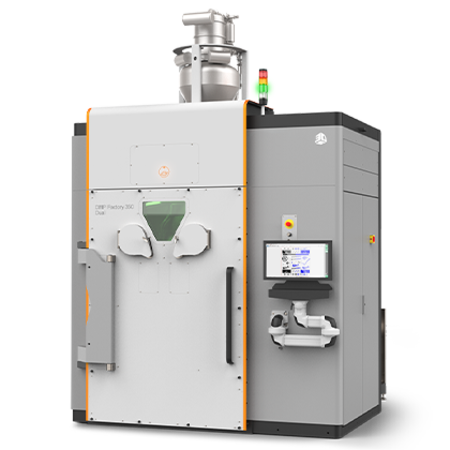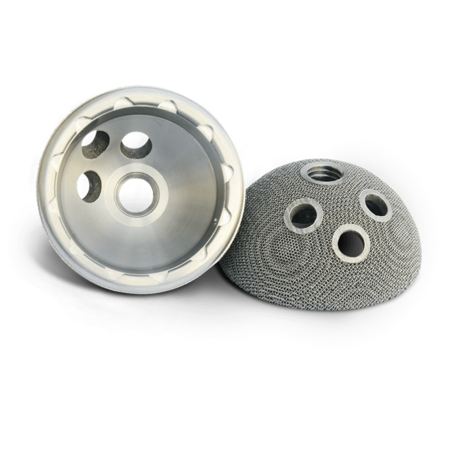Point Designs is an innovator in the field of partial hand prosthetic design and provides robust artificial digit solutions through a combination of additive manufacturing (AM), mechanical design, and clinical care. Founded by researchers out of the Biomechatronics Development Laboratory at the University of Colorado, Point Designs needed manufacturing support when demand for its products outpaced in-house capacity. By selecting 3D Systems as its production partner, Point Designs solved its supply issue and advanced its product development process. Through close collaboration with 3D Systems’ experts, the company transitioned from steel to titanium in just six months, gaining workflow efficiencies and valuable knowledge to advance its portfolio.
“Since working with 3D Systems we have really honed our design protocol in-house. 3D Systems has brought new perspective and knowledge about optimizing our designs for high volume 3D printing, improving post-processing methods, and increasing the yield of high precision components from each build plate.”
- Levin Sliker, Co-Founder & CEO, Point Designs
The Challenge
PARTNER TO SCALE AM PRODUCTION OF PARTIAL HAND PROSTHETIC COMPONENTS
With early access to lab resources at the University of Colorado, Point Designs created its Point Digit solution with 3D printing in mind from the very beginning. As the solution gained popularity, however, the company needed a partner to help grow its capacity. 3D Systems’ track record in medical device manufacturing, expertise in high quality, repeatable titanium printing, and intimate knowledge of AM technologies and processes guided Point Designs’ decision. Together, the companies adapted the Point Digit solution to titanium and fast-tracked its time-to-market to achieve functional, aesthetic, and optimized product components.
The Solution
01 Collaboration to Advance Design for Additive Manufacturing
When Point Designs engineered its Point Digit solution, it took advantage of the benefits of design for additive manufacturing (DfAM) by creating organic shapes, semi-hollow structures, and assemblies in situ. These types of features are uniquely enabled by AM and are a compelling reason for many to use the technology, enabling parts to be designed specifically for their intended function, at reduced weight, and with reduced assembly. However, achieving a successful 3D print can be tricky, especially when the final product entails detailed mechanisms which require strict tolerances. According to Point Designs CEO Levin Sliker, working with 3D Systems helped his team improve its designs to be optimized for the printing process.
One key AM-enabled feature that Point Designs uses is a live hinge, which is printed as an assembly in situ and allows rotation for more natural movement. Sliker says the ability to print this assembly in place is an incredible benefit because the hinge components are not only small, but they are internal components. “To assemble them any other way would be difficult, if not impossible,” says Sliker. “Not only would it be time-consuming, but you’d have to keep track of some really tiny parts. Printing everything in place with a live hinge really simplifies our assembly and manufacturing.”
02 Consultation for Optimized Print Strategy for Mass Production
Despite the short timeline to product launch, Point Designs had some design-related challenges to overcome when it started its work with 3D Systems, in particular when it came to part orientation. Point Designs had selected its existing build orientation to accommodate the critical dimensions and tight tolerances of its final parts. However, this orientation was not optimized for scaled production. 3D Systems and Point Designs worked together to devise a new print strategy that would enable substantially more parts to be printed in a single build while taking downstream processes into account. To avoid support scarring on critical surfaces, the two companies worked together to come up with support structures that would be easy to remove, as well as post-processing techniques to deliver the desired finish on those surfaces.
“Positioning the parts in a different orientation enabled us to double the amount of parts that we could produce on a single build plate.”
- Levin Sliker, Co-Founder & CEO, Point Designs
03 Transition to Premium Titanium Material
When Point Designs was searching for a manufacturing partner, its primary concern was capacity. By selecting 3D Systems, Sliker says it gained titanium as a bonus. But Point Designs is not the only one benefitting. Jeff Soelberg is an end-user of the Point Digit solution and has worn both the steel and titanium versions. With a 30% reduction in weight enabled by the new material, the difference was instantly noticeable. When wearing the steel device, Soelberg said it felt as if he was carrying around a small weight: “The switch to titanium feels so much lighter and much more natural,” he shared.
Beyond weight reduction, the material and design of these devices have earned a plethora of positive feedback from end-users because they offer strength, durability, and easy washing. Recipients can take them into any environment they would take their regular fingers. Soelberg said that with practice, he is back to doing 95% of the activities he pursued prior to his accident.
In transitioning materials, 3D Systems helped Point Designs navigate titanium-specific challenges, sharing know-how that will translate to future projects. Primary among these was assistance in designing to accommodate titanium’s shrink factor. “By working with the 3D Systems team we’ve definitely improved our design process for existing and future products, so that the next product will be easier to implement and quicker to achieve a frozen design file ready for mass production,” said Sliker.
The titanium Point Digit 2.0 solution is printed using 3D Systems’ direct metal printing (DMP) technology and LaserForm Ti Gr23 (A) material, which features best-in-class oxygen levels (<25 ppm) and an inert printing atmosphere, ensuring exceptionally strong and accurate parts with high chemical purity and repeatability. By using the same digital data package per part, 3D Systems machines enable scalability of production by delivering the same outcome across all DMP machines with no global off-sets.
04 Reduced Assembly
Point Designs and 3D Systems collaborate on four products, each comprised of multiple 3D printed components and available in multiple sizes for a total of 17 SKUs and 107 unique components. Once Point Designs receives the printed parts from 3D Systems, they are assembled by the Point Designs team using a combination of off-the-shelf and customized components. Following assembly, Point Designs delivers its products to a prosthetist, who creates a custom prosthetic socket for each recipient.
“The fact that 3D Systems’ Application Innovation Group could support us through printing using its own technology was really enabling for us,” says Sliker. “The familiarity 3D Systems has with the capabilities of its machines proved unique within the industry and has allowed this partnership to flourish.”
In terms of solving its supply issue, Griffin Drye, business development specialist at Point Designs, says that since working with 3D Systems, the companies have established a reliable production cadence and Point Designs hasn't since experienced any back-ordered products, which is a meaningful and welcomed achievement. This has been possible through the close and open communication between Point Designs and 3D Systems, allowing each to have visibility into the other’s timelines for accurate forecasting and planning. Following the successful launch of Point Digit 2.0, a Class I medical device, Point Designs is now pursuing numerous other prosthetic offerings which will leverage 3D Systems’ expertise.

